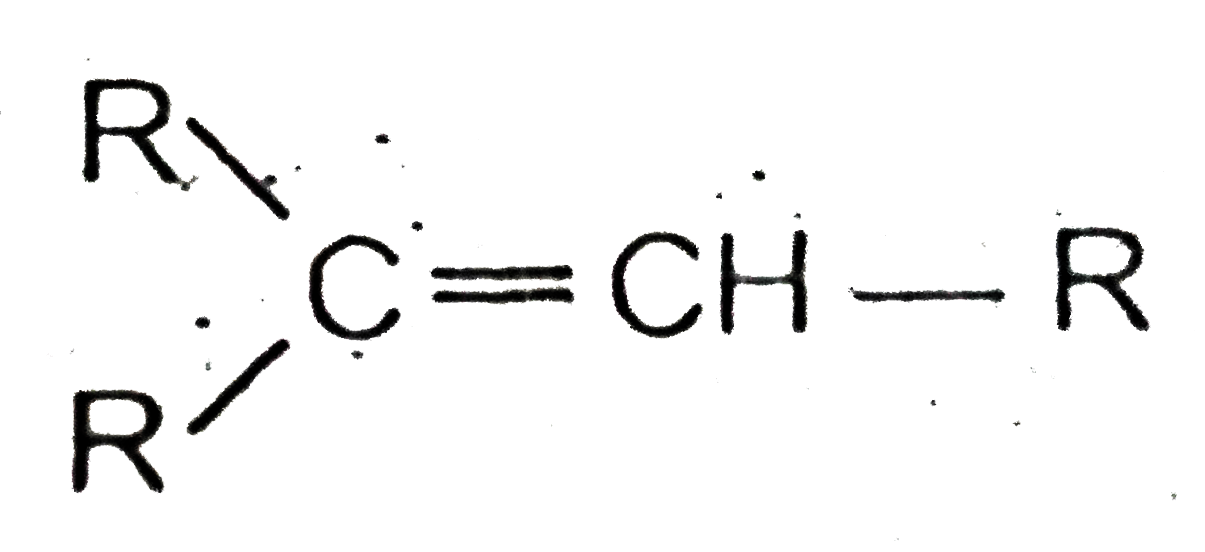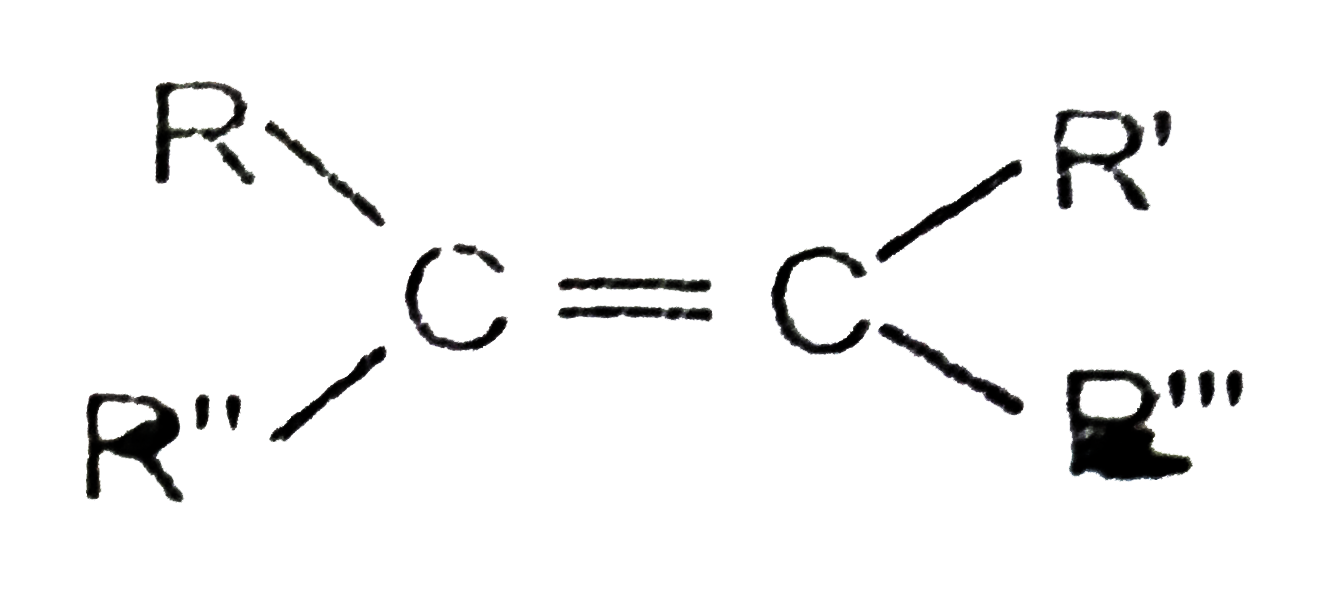In which of the following case product case product of oxidative and reductive ozonolysis is/are different?

(Cyclohexene)

The correct Answer is:A, B, C
To determine in which cases the products of oxidative and reductive ozonolysis are different, we will analyze the ozonolysis of various compounds step by step.
Step 1: Understand Ozonolysis
Ozonolysis is the oxidative cleavage of carbon-carbon double bonds (alkenes or alkynes) using ozone (O3). There are two types of ozonolysis:
- Oxidative Ozonolysis: Involves the use of oxidizing agents (like H2O2) and converts aldehydes into carboxylic acids.
- Reductive Ozonolysis: Involves reducing agents (like zinc dust) and typically stops at aldehydes and ketones without further oxidation.
Step 2: Analyze Each Option
Option 1: C=C with R groups
1. Oxidative Ozonolysis: Cleavage of the double bond leads to the formation of a ketone and an aldehyde. The aldehyde is then oxidized to a carboxylic acid.
- Products: Ketone and Carboxylic Acid
2. Reductive Ozonolysis: Cleavage of the double bond leads to the formation of a ketone and an aldehyde, but no further oxidation occurs.
- Products: Ketone and Aldehyde
3. Conclusion: Different products in oxidative and reductive ozonolysis.
Option 2: Cyclohexene
1. Oxidative Ozonolysis: Cleavage leads to the formation of aldehydes, which are oxidized to carboxylic acids.
- Products: Carboxylic Acid
2. Reductive Ozonolysis: Cleavage leads to aldehydes, which do not undergo further oxidation.
- Products: Aldehyde
3. Conclusion: Different products in oxidative and reductive ozonolysis.
Option 3: Ethene
1. Oxidative Ozonolysis: Cleavage leads to the formation of formaldehyde, which is oxidized to carbon dioxide and water.
- Products: Carbon Dioxide and Water
2. Reductive Ozonolysis: Cleavage leads to formaldehyde, with no further oxidation.
- Products: Formaldehyde
3. Conclusion: Different products in oxidative and reductive ozonolysis.
Option 4: C=C with R, R', R'' groups
1. Oxidative Ozonolysis: Cleavage leads to the formation of ketones.
- Products: Ketone
2. Reductive Ozonolysis: Cleavage also leads to the formation of ketones.
- Products: Ketone
3. Conclusion: Same products in both oxidative and reductive ozonolysis.
Final Conclusion:
- Different Products: Options 1, 2, and 3.
- Same Products: Option 4.
Answer:
The products of oxidative and reductive ozonolysis are different in options 1, 2, and 3.
---
Ozonolysis is the oxidative cleavage of carbon-carbon double bonds (alkenes or alkynes) using ozone (O3). There are two types of ozonolysis:
- Oxidative Ozonolysis: Involves the use of oxidizing agents (like H2O2) and converts aldehydes into carboxylic acids.
- Reductive Ozonolysis: Involves reducing agents (like zinc dust) and typically stops at aldehydes and ketones without further oxidation.
1. Oxidative Ozonolysis: Cleavage of the double bond leads to the formation of a ketone and an aldehyde. The aldehyde is then oxidized to a carboxylic acid.
- Products: Ketone and Carboxylic Acid
2. Reductive Ozonolysis: Cleavage of the double bond leads to the formation of a ketone and an aldehyde, but no further oxidation occurs.
- Products: Ketone and Aldehyde
3. Conclusion: Different products in oxidative and reductive ozonolysis.
1. Oxidative Ozonolysis: Cleavage leads to the formation of aldehydes, which are oxidized to carboxylic acids.
- Products: Carboxylic Acid
2. Reductive Ozonolysis: Cleavage leads to aldehydes, which do not undergo further oxidation.
- Products: Aldehyde
3. Conclusion: Different products in oxidative and reductive ozonolysis.
1. Oxidative Ozonolysis: Cleavage leads to the formation of formaldehyde, which is oxidized to carbon dioxide and water.
- Products: Carbon Dioxide and Water
2. Reductive Ozonolysis: Cleavage leads to formaldehyde, with no further oxidation.
- Products: Formaldehyde
3. Conclusion: Different products in oxidative and reductive ozonolysis.
1. Oxidative Ozonolysis: Cleavage leads to the formation of ketones.
- Products: Ketone
2. Reductive Ozonolysis: Cleavage also leads to the formation of ketones.
- Products: Ketone
3. Conclusion: Same products in both oxidative and reductive ozonolysis.
- Different Products: Options 1, 2, and 3.
- Same Products: Option 4.
The products of oxidative and reductive ozonolysis are different in options 1, 2, and 3.
Topper's Solved these Questions
- HYDROCARBONSBOOK - AAKASH INSTITUTE ENGLISHCHAPTER - HYDROCARBONSEXERCISE - SECTION-D LINKED COMPREHENSION TYPE QUESTIONS
7 Videos
- HYDROCARBONSBOOK - AAKASH INSTITUTE ENGLISHCHAPTER - HYDROCARBONSEXERCISE - SECTION-E ASSERTION-REASON TYPE QUESTIONS:
9 Videos
- HYDROCARBONSBOOK - AAKASH INSTITUTE ENGLISHCHAPTER - HYDROCARBONSEXERCISE - SECTION-B OBJECTIVE TYPE QUESTIONS (ONE OPTION IS CORRECT)
25 Videos
- HALOALKANES AND HALOARENES BOOK - AAKASH INSTITUTE ENGLISHCHAPTER - HALOALKANES AND HALOARENES EXERCISE - ASSIGNMENT SECTION -D
15 Videos
- HYDROGENBOOK - AAKASH INSTITUTE ENGLISHCHAPTER - HYDROGENEXERCISE - ASSIGNMENT (SECTION - D) (Assertion-Reason Type question)
15 Videos
Similar Questions
Knowledge Check
In which of the following cases, the major product has been correctly shown?
A B
B C
C D
D
In which of the following cases entropy decreases?
View SolutionFor which of the following cases, answer is 4
View SolutionWhich of the following products can be obtained by reductive ozonolysis of o-xylene ?

View SolutionWhich of the following can be used both as an oxidant and a reductant?
View SolutionGive the products of reductive and oxidative ozonolysis of toluene
View SolutionWhich of the following is a case of auto-alloploidy?
View SolutionWhich of the following act both as oxidant & reductant :-
View Solution
